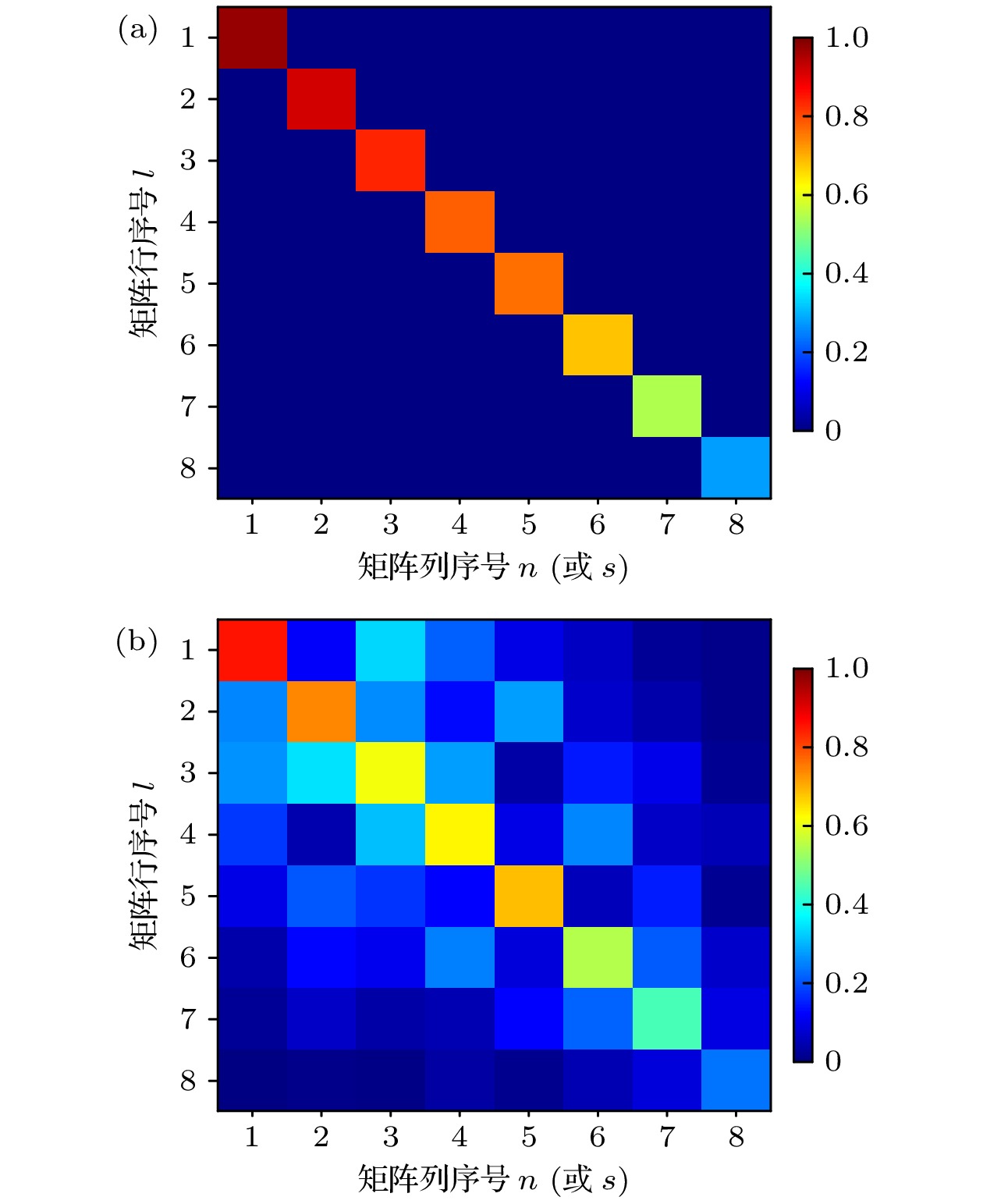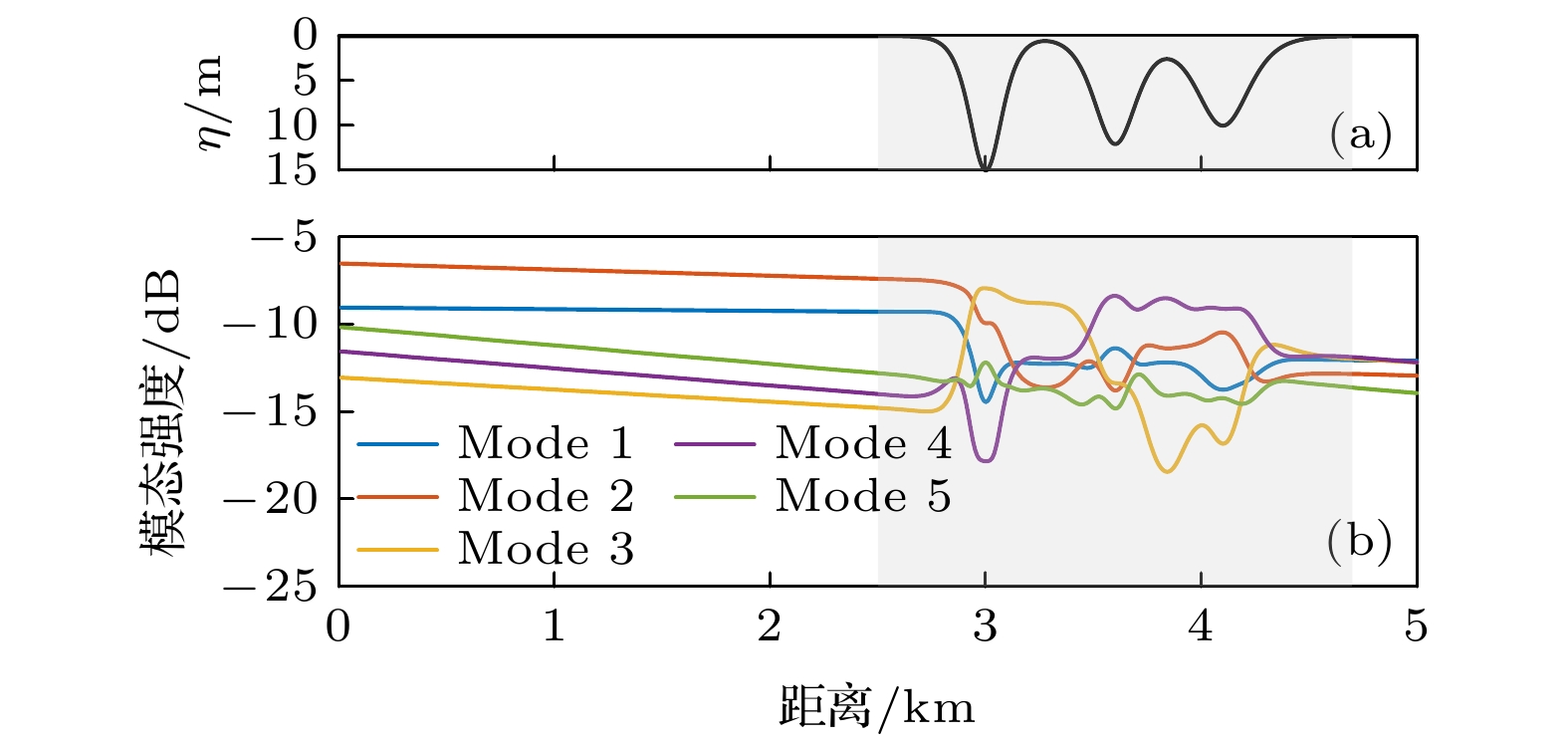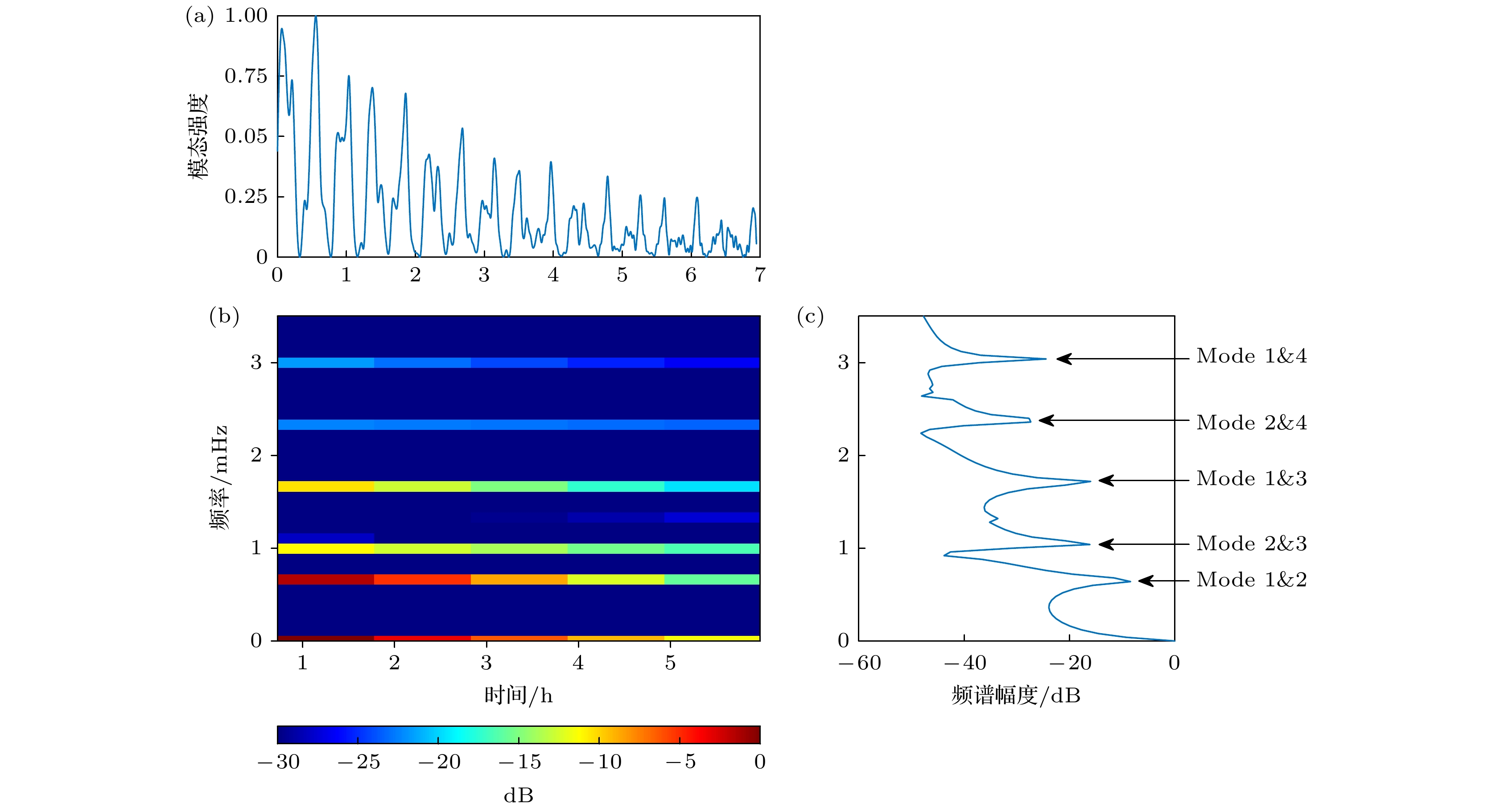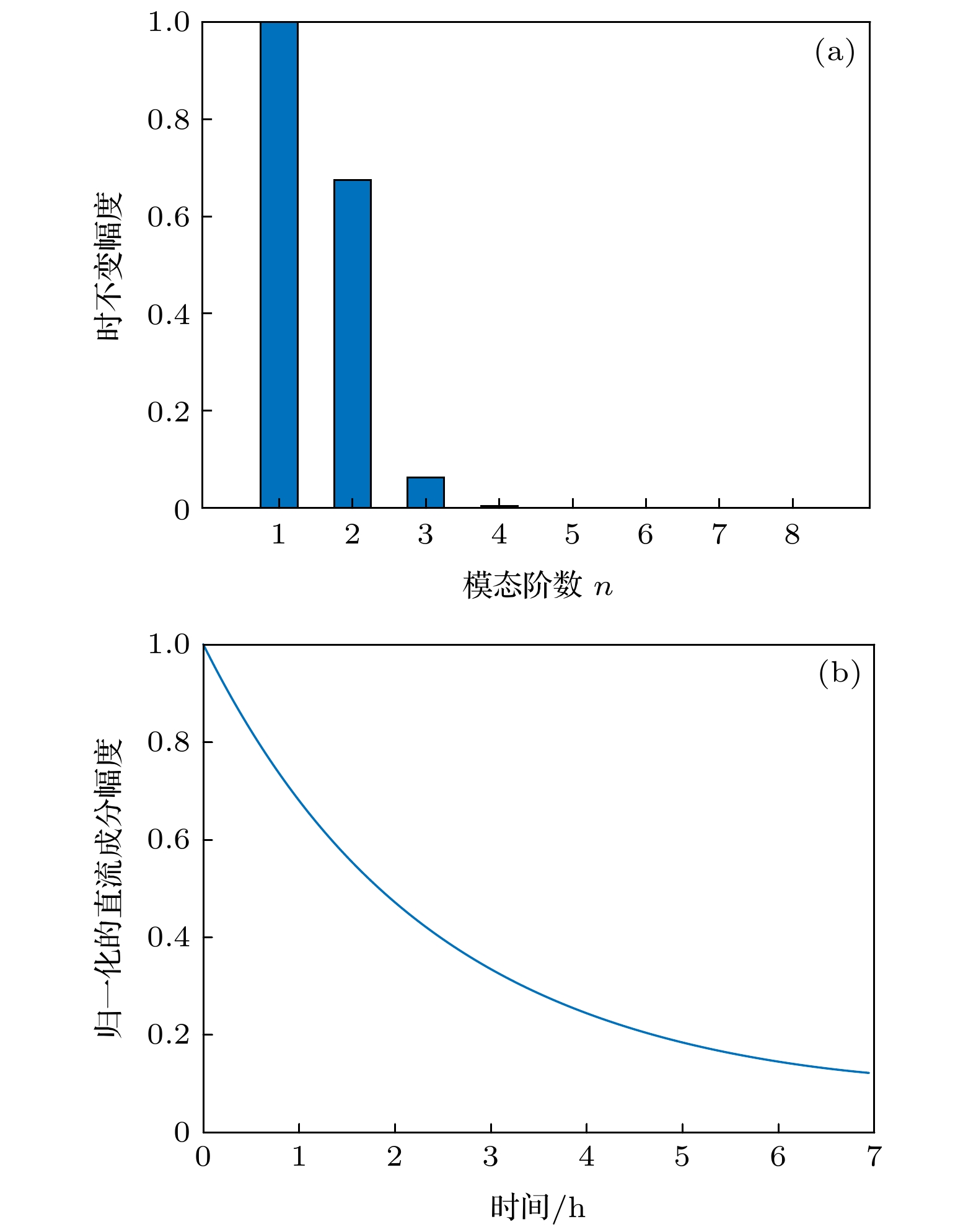-
内孤立波是一种常见于浅海海域的非线性内波, 具有振幅大、周期短和流速强等特点, 它通过扰动水体中的温盐分布使声速剖面产生明显的距离依赖性, 进而影响水下声传播特性. 内波自生成后通常以1 m/s 量级的速度传播, 运动的内波使声传播路径上的声波模态能量在空间和时间上剧烈起伏. 本文定义模态强度为模态系数模值 (模态幅度) 的平方, 并用其衡量各阶模态所含声能量的大小. 文中基于耦合简正波理论, 推导了内波运动时声波模态强度起伏的表达式, 将模态强度表征为振荡项和趋势项的线性叠加. 以往的工作大多局限于单独从时域或频域研究内波运动时声波模态强度的时变规律, 本文则结合短时傅里叶变换在时频平面上揭示了模态强度的起伏机理. 理论推导和数值仿真均表明内孤立波使各阶声波模态之间发生能量交换, 即模态耦合. 内波的动态传播进一步引起模态干涉, 这种干涉效应表现为模态强度中的振荡项并使模态强度随时间快速起伏. 受模态剥离效应 (不同阶模态之间衰减系数的差异) 的影响, 趋势项的幅度随时间不断变化, 进而对模态干涉引起的振荡叠加了时变的偏置. 模态强度的整体走势和振荡项中各频率分量振幅的时变特征均与模态衰减密切相关. 同时, 本文使用深度积分声强作为总接收声场强度的度量, 研究了内波运动时模态强度起伏对接收阵位置处声能量的影响. 结果表明, 能量较大且起伏剧烈的模态强度将主导总接收声强的变化.Internal solitary wave (ISW) is a kind of nonlinear internal wave commonly observed in the shallow water, which has the characteristics of large amplitude, short period and strong current velocity. With the distribution of the temperature and the salinity in the water column perturbed by ISWs, the sound speed profile becomes range-dependent, and thus affecting the characteristics of the underwater acoustic propagation. The ISWs usually propagate at a speed of the order of 1 m/s , and moving internal waves cause the energy in each acoustic mode to fluctuate dramatically. In this paper, the modal intensity is defined as the squared modulus of the modal coefficient, and is used to measure the sound energy in each mode. Based on the coupled mode theory, the expression of the acoustic modal intensity during the propagation of internal waves is derived in this paper, and the modal intensity is taken as the linear superposition of the oscillating term and the trend term. Most of previous researches were limited to the study of the time-varying characteristics of the acoustic modal intensity during the propagation of internal waves in the time domain or frequency domain. In this paper, the mechanism of modal intensity fluctuations is studied simultaneously in the time domain and the frequency domain with the aid of the short-time Fourier transform. Both the theoretical derivation and the numerical simulation show that the internal solitary wave gives rise to the energy transfer among acoustic modes, i.e., the mode coupling. The dynamic propagation of internal waves further leads to the modal interference, which behaves as an oscillating term in the modal intensity, and causes the modal intensity to fluctuate rapidly with time. The amplitude of the trend term changes with time due to the mode stripping (the difference in attenuation coefficients between different modes), which in turn adds a time-varying offset to the oscillations induced by the modal interference. The trend of the modal intensity and the time-varying characteristics of the amplitude of each frequency component in the oscillating term are closely associated with the modal attenuation. Meanwhile, the depth-integrated intensity is chosen as the measure of the total received acoustic intensity, and the influences of modal intensity fluctuations on the acoustic energy at the receivers during the propagation of internal waves are studied. It is demonstrated that the modal intensity with high energy which oscillates most dramatically will dominate the temporal variation of the received acoustic energy.
[1] 方欣华, 杜涛 2005 海洋内波基础和中国海内波 (青岛: 中国海洋大学出版社) 第109页
Fang X H, Du T 2005 Fundamentals of Oceanic Internal Waves and Internal Waves in the China Seas (Qingdao: China Ocean University Press) p109 (in Chinese)
[2] Magalhaes J M, da Silva J C B, Buijsman M C 2020 Sci. Rep. 10 1
 Google Scholar
Google Scholar
[3] Chiu C S, Ramp S R, Miller C W, Lynch J F, Duda T F, Tang T Y 2004 IEEE J. Oceanic Eng. 29 1249
 Google Scholar
Google Scholar
[4] Duda T F, Lynch J F, Newhall A E, Wu L X, Chiu C S 2004 IEEE J. Oceanic Eng. 29 1264
 Google Scholar
Google Scholar
[5] Oba R, Finette S 2002 J. Acoust. Soc. Am. 111 769
 Google Scholar
Google Scholar
[6] Duda T F 2006 J. Acoust. Soc. Am. 119 3717
 Google Scholar
Google Scholar
[7] Headrick R H, Lynch J F, Kemp J N, Newhall A E, von der Heydt K, Apel J, Badiey M, Chiu C S, Finette S, Orr M, and Pasewark B, Turgot A, Wolf S, Tielbuerger D 2000 J. Acoust. Soc. Am. 107 201
 Google Scholar
Google Scholar
[8] Headrick R H, Lynch J F, Kemp J N, Newhall A E, von der Heydt K, Apel J, Badiey M, Chiu C S, Finette S, Orr M, Pasewark B, Turgot A, Wolf S, Tielbuerger D 2000 J. Acoust. Soc. Am. 107 221
 Google Scholar
Google Scholar
[9] Zhou J X, Zhang X Z, Rogers P H 1991 J. Acoust. Soc. Am. 90 2042
 Google Scholar
Google Scholar
[10] Duda T F, Preisig J C 1999 IEEE J. Oceanic Eng. 24 16
 Google Scholar
Google Scholar
[11] Apel J R, Badiey M, Chiu C S, Finette S, Headrick R, Kemp J, Lynch J F, Newhall A, Orr M H, Pasewark B H, Tielbuerger D, Turgut A, von der Heydt K, Wolf S 1997 IEEE J. Oceanic Eng. 22 465
 Google Scholar
Google Scholar
[12] Rouseff D, Turgut A, Wolf S N, Finette S, Orr M H, Pasewark B H, Apel J R, Badiey M, Chiu C S, Headrick R H, Lynch J F, Kemp J N, Newhall A E, von der Heydt K, Tielbuerger D 2002 J. Acoust. Soc. Am. 111 1655
 Google Scholar
Google Scholar
[13] 刘进忠, 王宁, 高大治 2006 声学学报 31 322
 Google Scholar
Google Scholar
Liu J Z, Wang N, Gao D Z 2006 Acta Acustia 31 322
 Google Scholar
Google Scholar
[14] 胡涛, 王臻, 郭圣明, 马力 2020 哈尔滨工程大学学报 41 1518
Hu T, Wang Z, Guo S M, Ma L 2020 J. Harbin Eng. Univ. 41 1518
[15] Finette S, Orr M H, Turgut A, Apel J R, Badiey M, Chiu C S, Headrick R H, Kemp J N, Lynch J F, Newhall A E, von der Heydt K, Pasewark B, Wolf S N, Tielbuerger D 2000 J. Acoust. Soc. Am. 108 957
 Google Scholar
Google Scholar
[16] Apel J R 2003 J. Phys. Oceanogr. 33 2247
 Google Scholar
Google Scholar
[17] Yang T C 2014 J. Acoust. Soc. Am. 135 610
 Google Scholar
Google Scholar
[18] Dozier L B, Tappert F D 1978 J. Acoust. Soc. Am. 63 353
 Google Scholar
Google Scholar
[19] 秦继兴, Katsnelson Boris, 李整林, 张仁和, 骆文于 2016 声学学报 41 145
Qin J X, Boris K, Li Z L, Zhang R H, Luo W Y 2016 Acta Acustia 41 145
[20] 宋文华, 胡涛, 郭圣明, 马力 2014 物理学报 63 194303
 Google Scholar
Google Scholar
Song W H, Hu T, Guo S M, Ma L 2014 Acta Phys. Sin. 63 194303
 Google Scholar
Google Scholar
[21] Song W H, Wang N, Gao D Z, Wang H Z, Hu T, Guo S M 2017 J. Acoust. Soc. Am. 142 1848
 Google Scholar
Google Scholar
[22] Evans R B 1983 J. Acoust. Soc. Am. 74 188
 Google Scholar
Google Scholar
[23] Sperry B J 1999 Ph. D. Dissertation (Woods Hole: Massachussetts Institute of Technology/Woods Hole Oceanographic Institution)
[24] Colosi J A 2016 Sound Propagation Through the Stochastic Ocean (Cambridge: Cambridge University Press) p83
[25] Buck J R, Preisig J C, Wage K E 1998 J. Acoust. Soc. Am. 103 1813
 Google Scholar
Google Scholar
[26] Katsnelson B, Petnikov V, Lynch J 2012 Fundamentals of Shallow Water Acoustics (Boston: Springer) pp83–85
[27] Jensen F B, Kuperman W A, Porter M B, Schmidt H 2011 Computational Ocean Acoustics (New York: Springer) p85, 473
[28] Lee D, McDaniel S T 1988 Ocean Acoustic Propagation by Finite Difference Methods (Amsterdam: Elsevier) p386
[29] Porter M B 1992 The KRAKEN Normal Mode Program (Washington DC: Naval Research Laboratory)
-
表 1 深度积分声强和各阶模态强度起伏的均值和标准差
Table 1. Mean values and the standard deviations of the depth-integrated intensity and the modal intensities.
声学量 均值 标准差 $ \bar I(T) \times{r_{\rm{e}}} $ 0.0694 0.0116 $|a_l(T)|^{2}_{l=1}\times{r_{\rm{e}}}$ 0.0514 0.0144 $|a_l(T)|^{2}_{l=2}\times{r_{\rm{e}}}$ 0.0151 0.0079 $|a_l(T)|^{2}_{l=3}\times{r_{\rm{e}}}$ 0.0024 0.0026 $|a_l(T)|^{2}_{l=4}\times{r_{\rm{e}}}$ 3.60 × 10–4 4.45 × 10–4 $|a_l(T)|^{2}_{l=5}\times{r_{\rm{e}}}$ 2.96 × 10–4 3.87 × 10–4 $|a_l(T)|^{2}_{l=6}\times{r_{\rm{e}}}$ 4.43 × 10–5 8.52 × 10–5 $ |a_l(T)|^{2}_{l=7}\times{r_{\rm{e}}} $ 4.30 × 10–6 1.22 × 10–5 $ |a_l(T)|^{2}_{l=8}\times{r_{\rm{e}}} $ 7.34 × 10–9 3.11 × 10–8 -
[1] 方欣华, 杜涛 2005 海洋内波基础和中国海内波 (青岛: 中国海洋大学出版社) 第109页
Fang X H, Du T 2005 Fundamentals of Oceanic Internal Waves and Internal Waves in the China Seas (Qingdao: China Ocean University Press) p109 (in Chinese)
[2] Magalhaes J M, da Silva J C B, Buijsman M C 2020 Sci. Rep. 10 1
 Google Scholar
Google Scholar
[3] Chiu C S, Ramp S R, Miller C W, Lynch J F, Duda T F, Tang T Y 2004 IEEE J. Oceanic Eng. 29 1249
 Google Scholar
Google Scholar
[4] Duda T F, Lynch J F, Newhall A E, Wu L X, Chiu C S 2004 IEEE J. Oceanic Eng. 29 1264
 Google Scholar
Google Scholar
[5] Oba R, Finette S 2002 J. Acoust. Soc. Am. 111 769
 Google Scholar
Google Scholar
[6] Duda T F 2006 J. Acoust. Soc. Am. 119 3717
 Google Scholar
Google Scholar
[7] Headrick R H, Lynch J F, Kemp J N, Newhall A E, von der Heydt K, Apel J, Badiey M, Chiu C S, Finette S, Orr M, and Pasewark B, Turgot A, Wolf S, Tielbuerger D 2000 J. Acoust. Soc. Am. 107 201
 Google Scholar
Google Scholar
[8] Headrick R H, Lynch J F, Kemp J N, Newhall A E, von der Heydt K, Apel J, Badiey M, Chiu C S, Finette S, Orr M, Pasewark B, Turgot A, Wolf S, Tielbuerger D 2000 J. Acoust. Soc. Am. 107 221
 Google Scholar
Google Scholar
[9] Zhou J X, Zhang X Z, Rogers P H 1991 J. Acoust. Soc. Am. 90 2042
 Google Scholar
Google Scholar
[10] Duda T F, Preisig J C 1999 IEEE J. Oceanic Eng. 24 16
 Google Scholar
Google Scholar
[11] Apel J R, Badiey M, Chiu C S, Finette S, Headrick R, Kemp J, Lynch J F, Newhall A, Orr M H, Pasewark B H, Tielbuerger D, Turgut A, von der Heydt K, Wolf S 1997 IEEE J. Oceanic Eng. 22 465
 Google Scholar
Google Scholar
[12] Rouseff D, Turgut A, Wolf S N, Finette S, Orr M H, Pasewark B H, Apel J R, Badiey M, Chiu C S, Headrick R H, Lynch J F, Kemp J N, Newhall A E, von der Heydt K, Tielbuerger D 2002 J. Acoust. Soc. Am. 111 1655
 Google Scholar
Google Scholar
[13] 刘进忠, 王宁, 高大治 2006 声学学报 31 322
 Google Scholar
Google Scholar
Liu J Z, Wang N, Gao D Z 2006 Acta Acustia 31 322
 Google Scholar
Google Scholar
[14] 胡涛, 王臻, 郭圣明, 马力 2020 哈尔滨工程大学学报 41 1518
Hu T, Wang Z, Guo S M, Ma L 2020 J. Harbin Eng. Univ. 41 1518
[15] Finette S, Orr M H, Turgut A, Apel J R, Badiey M, Chiu C S, Headrick R H, Kemp J N, Lynch J F, Newhall A E, von der Heydt K, Pasewark B, Wolf S N, Tielbuerger D 2000 J. Acoust. Soc. Am. 108 957
 Google Scholar
Google Scholar
[16] Apel J R 2003 J. Phys. Oceanogr. 33 2247
 Google Scholar
Google Scholar
[17] Yang T C 2014 J. Acoust. Soc. Am. 135 610
 Google Scholar
Google Scholar
[18] Dozier L B, Tappert F D 1978 J. Acoust. Soc. Am. 63 353
 Google Scholar
Google Scholar
[19] 秦继兴, Katsnelson Boris, 李整林, 张仁和, 骆文于 2016 声学学报 41 145
Qin J X, Boris K, Li Z L, Zhang R H, Luo W Y 2016 Acta Acustia 41 145
[20] 宋文华, 胡涛, 郭圣明, 马力 2014 物理学报 63 194303
 Google Scholar
Google Scholar
Song W H, Hu T, Guo S M, Ma L 2014 Acta Phys. Sin. 63 194303
 Google Scholar
Google Scholar
[21] Song W H, Wang N, Gao D Z, Wang H Z, Hu T, Guo S M 2017 J. Acoust. Soc. Am. 142 1848
 Google Scholar
Google Scholar
[22] Evans R B 1983 J. Acoust. Soc. Am. 74 188
 Google Scholar
Google Scholar
[23] Sperry B J 1999 Ph. D. Dissertation (Woods Hole: Massachussetts Institute of Technology/Woods Hole Oceanographic Institution)
[24] Colosi J A 2016 Sound Propagation Through the Stochastic Ocean (Cambridge: Cambridge University Press) p83
[25] Buck J R, Preisig J C, Wage K E 1998 J. Acoust. Soc. Am. 103 1813
 Google Scholar
Google Scholar
[26] Katsnelson B, Petnikov V, Lynch J 2012 Fundamentals of Shallow Water Acoustics (Boston: Springer) pp83–85
[27] Jensen F B, Kuperman W A, Porter M B, Schmidt H 2011 Computational Ocean Acoustics (New York: Springer) p85, 473
[28] Lee D, McDaniel S T 1988 Ocean Acoustic Propagation by Finite Difference Methods (Amsterdam: Elsevier) p386
[29] Porter M B 1992 The KRAKEN Normal Mode Program (Washington DC: Naval Research Laboratory)
计量
- 文章访问数: 8026
- PDF下载量: 122
- 被引次数: 0













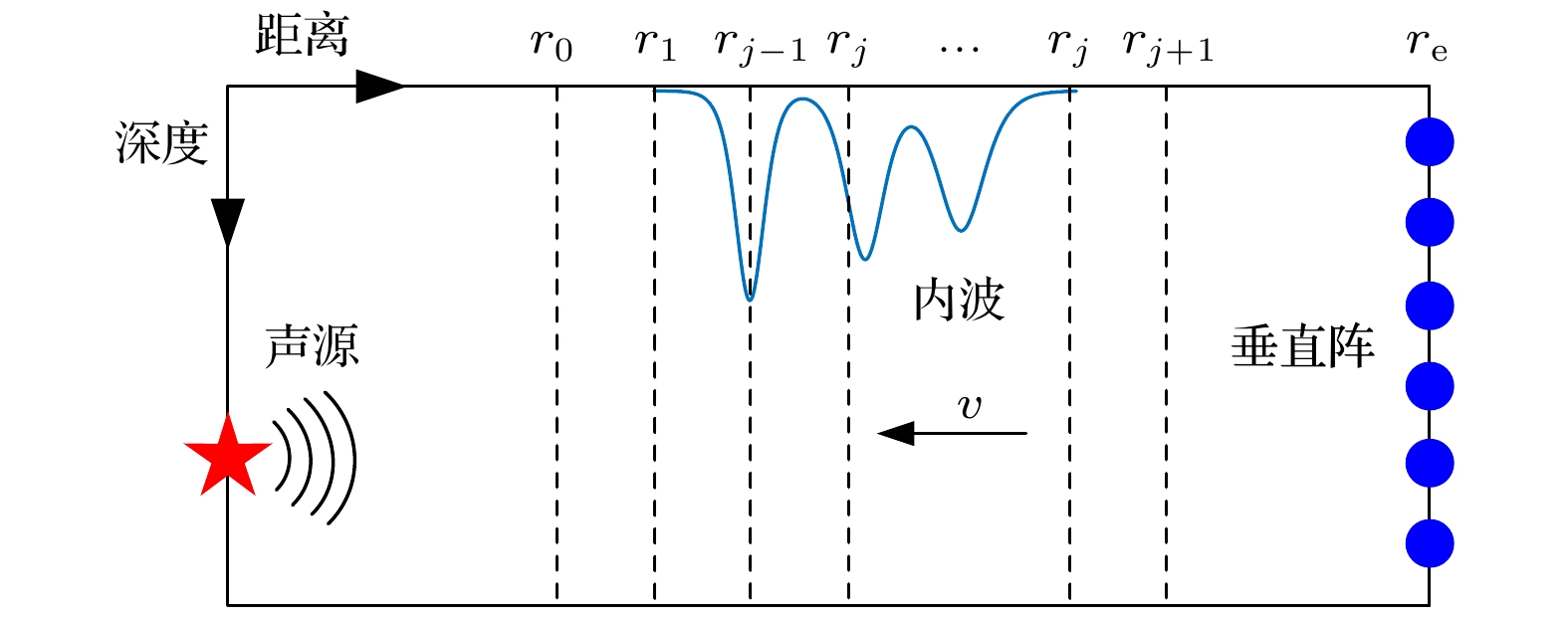
 下载:
下载:

